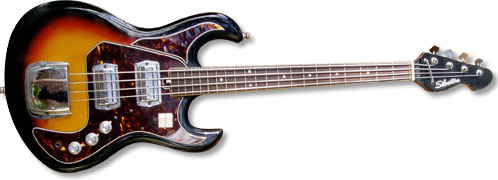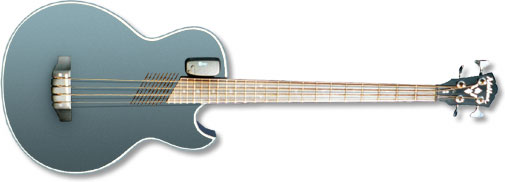|
||||

This was my first bass, which I got for Christmas in 1970. (In the months preceding, I had pestered my dad relentlessly to get me a bass guitar. He finally gave in, probably just so I'd shut up about it. Thanks, Dad.) Silvertone was a brand sold by Sears at the time for about $75.00. It has a short scale neck, and came with flatwounds, as was standard in those days. It appeared to be Japan's take on a Fender Jazz Bass, but the pickups sound more like a Gibson EB-0. The other bass that the Sears catalogue offered at that time was a Japanese copy of a Hofner Beatle Bass. As a young teenager, I was into Grand Funk Railroad, so I chose this bass, because it looked more like the bass that Mel Schacher had. His was a 1970 Jazz Bass which he had routed for an EB-0 pickup to replace the front J pickup. When I cranked up my Sears bass amp, it distorted like bloody hell, which was the basic sound that Mel had. I was in heaven, and spent weeks playing along with GFR records, pretending I was Mel. Ah, good times...

While not exactly period accurate, this is still a very nice bass. It is modeled after the very first bass that Leo Fender designed. The original ’51 had a “slab” body with a butterscotch finish and a black pickguard. The “slab” body design refers to the uncontoured edges. They are all squared off, which can get uncomfortable after a while. Beginning in 1954, Leo introduced contoured edges to his design, much to the relief of the bass world.
This bass retains the slab body, but sports the brown sunburst finish introduced in 1953. The neck is not quite as bulky as some of the originals I’ve played, which is nice. Since this is not a real 1951 P Bass, I took the liberty of modifying it to better suit my needs. I removed the cool-but-cluttered chrome covers, and added a real 1960 Jazz Bass pickup in the bridge position. Now I have the best of both worlds. I can still get the old school P bass sound when I want it, or add a little snap to the sound with the back pickup. Soloed, the ’60 Jazz pickup puts out a nice Jaco-esque midrange 'bone tone." Life is good.
1975 Fender Jazz Bass

This bass is my other current favorite. I bought it several years ago after someone had traded it in to a music store. The body is northern ash, which is much heavier than swamp ash. To help balance the instrument, these necks were a bit chunkier than most other Jazz Bass models. The combination of an ash body and maple fingerboard make this instrument perfect for slapping. It just begs to be spanked. If you ever get your hands on one, you'll know why Marcus Miller likes his so much.
Hear this bass in action on the tune "Run For Cover."

This bass is my other current favorite. I bought it several years ago after someone had traded it in to a music store. The body is northern ash, which is much heavier than swamp ash. To help balance the instrument, these necks were a bit chunkier than most other Jazz Bass models. The combination of an ash body and maple fingerboard make this instrument perfect for slapping. It just begs to be spanked. If you ever get your hands on one, you'll know why Marcus Miller likes his so much.
Hear this bass in action on the tune "Run For Cover."

I bought this bass for $200 in 1978 and pulled the frets out, epoxied the fingerboard, added a fingerboard extension, brass nut, and Badass bridge. The pickups are still original. It sings!
Hear this bass in action on the tune "The Real Mr. Gone."
For more information about this tune, click here.

Unfortunately, I no longer own this bass. It was one of the very first Jazz Basses made. The neck was very narrow at the nut. I left the frets in this one.

I owned this bass for about 13 years. Eventually, I found myself favoring the Fender basses over the Sadowsky. It seems that I’ve gone full circle. After years of playing active basses, I’ve come to appreciate the old school quality of passive basses once again. There’s just something about those old Fenders…

This was a sympathy present from my wife. Several years ago, I broke my right hand in a car accident. One day soon thereafter, I spotted this bass in a guitar shop window. It had been marked down quite a bit. Not being one to pass up a good deal, I went in to play it and loved the organic sound. At the time, I still had my hand in a cast with just my thumb and fingers exposed. The only way I could actually play it was using my thumb and first two fingers in a guitar finger picking style. The cast kind of muted the strings. (That's how I developed that technique, which I still use on bass quite a bit. Sans cast.) I sometimes string this bass A-D-G-C. Sounds like an acoustic guitar on steroids.
Hear this bass in action on the tune "Reston Piece."
For more information about this tune, click here.

This bass was built for me in 1992 by The Guitar Factory in Orlando, Florida. If you're ever down that way, say "hello" to Doug and Bill for me. The body is soft maple, with a flamed maple top. The neck-through center is also maple. I call it my "Chiropractor Special" because it's so heavy. It does however have the best low "B" I've ever heard on a 34" scale bass. It also features some unique electronics. Each pickup has its own preamp and bass/treble control. The preamps are summed at the output stage, so there's no "loading" or loss of frequency response. To my knowledge, this was the first seven string bass built. I had never seen one prior to this one. It was featured in the December 1993 issue of Bass Player magazine.
Hear this bass in action on the tune "Three Views of a Secret."
For more information about this tune, click here.